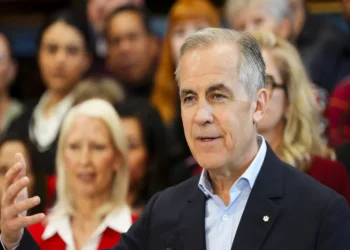Secretary of Defense Pete Hegseth admitted that he shared information over Signal on Tuesday morning, though he maintained the details were “informal” and “unclassified.”
In mid-March, he shared details of impending attacks on the Houthis in Yemen in at least two separate Signal group chats, a platform that, while secure, is not approved by the government for the sharing of classified information.
“What was shared over Signal then and now, however you characterize it, was informal, unclassified coordinations for media coordination [and] other things. That’s what I’ve said from the beginning,” he told Fox & Friends host Brian Kilmeade on Tuesday morning.
“If you remember when this all started the first go around, because this is the second go around, right? They pedal old stuff. They kick it back up,” Hegseth said. “I said repeatedly, no one’s texting war plans. You know why I said that? Because I’m in the bowels of the Pentagon every single day.”
One of those chats was created by President Donald Trump’s national security adviser, Mike Waltz, and included more than a dozen cabinet officials, inadvertently including an Atlantic journalist. Hegseth created the other group chat before his Senate confirmation, including his wife, Jennifer; his brother, Phil, who works as a liaison between the Departments of Defense and Homeland Security; and his personal attorney, among others.
It’s unclear why the people in the second group chat, “Defense | Team Huddle,” would need to know the details regarding the operations against the Houthis in Yemen.
Central Command commander Gen. Michael Erik Kurilla reportedly provided the details Hegseth sent in those group chats — regarding when U.S. fighters would take off and hit their targets — from a secure government system, according to NBC News. Hegseth allegedly shared some of those details in the group chats from his personal device days after an aide cautioned him about sharing sensitive information on unsecure communications systems.
The Atlantic published the contents of the first group chat with senior officials, showing that the secretary said, “We are a GO for mission launch,” while sharing that F-18 fighter aircraft, MQ-9 drones, and the Navy firing sea-based Tomahawk missiles would be used in the operation.
He shared similar information, including the flight schedules for the F/A-18 Hornets involved in the mission, in the secondary chat, according to the New York Times.
The secretary blamed the new story about the second group chat on three former officials who were fired last week. Two of them were reported to have been in the chat with Hegseth’s wife and brother. While the secretary said they had been linked to several leaks from the Pentagon, the entire trio has denied wrongdoing.
“When you dismiss people who you believe are leaking classified information, and again, the investigation is ongoing and that will take time, and when the evidence is produced, it will go to the DOJ, why would it surprise anyone, Brian, if those very same people keep leaking to the very same reporters whatever information they think they can have to try to sabotage the agenda of the president or the secretary?” he said. “So, once a leaker, always a leaker, often a leaker, and so we look for leakers because we take it very seriously and we will do the investigation.”
Senior adviser Dan Caldwell, deputy chief of staff Darin Selnick, and Colin Carroll, chief of staff to the deputy secretary of defense — the fired officials — released a joint statement over the weekend: “We still have not been told what exactly we were investigated for, if there is still an active investigation, or if there was even a real investigation of ‘leaks’ to begin with.”
Hegseth did leave open the possibility that they could be exonerated, though he also said any evidence would be handed over to the Department of Justice for charges.
“If one or two of these guys is exonerated after an investigation, great,” he said. “That’s what investigations are for. But we took it seriously. It led to some unfortunate places, people I have known for quite some time, but it’s not my job to protect them. It’s my job to protect national security, the President of the United States, and let the investigation go where it is.”
“So when that evidence is gathered sufficiently, this has all happened very quickly. It will be handed over to the DOJ, and those people will be prosecuted if necessary,” he added.
Trump and all but one congressional Republican have remained supportive of Hegseth, though the DoD Office of the Inspector General is evaluating his use of Signal. White House press secretary Karoline Leavitt denied a report that the process had begun to replace Hegseth.
There is upheaval around Hegseth in addition to the loss of the three aides and advisers.
The secretary also confirmed that his chief of staff, Joe Kasper, who launched the leak investigation on March 21, will be reassigned within the department. Former interim top Pentagon spokesman John Ullyot, who served in the first Trump administration, also left the department last week.
PETE HEGSETH SIGNAL GROUP CHAT (PART 2): WHAT YOU NEED TO KNOW
“It’s been a month of total chaos at the Pentagon,” Ullyot wrote for Politico. “Even strong backers of the secretary like me must admit: The last month has been a full-blown meltdown at the Pentagon — and it’s becoming a real problem for the administration.”
Hegseth took a shot at Ullyot during the interview, saying, “Anybody that knows John knows why we let him go. We did a lot of favors for John. He did some good work up front. Then he was moved along and asked to move along. Now he’s misrepresented a lot of things in the press.”















